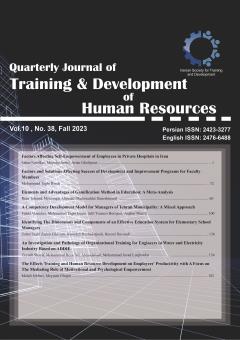-
-
List of Articles
-
Open Access Article
1 - Factors Affecting Self-Empowerment of Employees in Private Hospitals in Iran
sahar nazifkar mojtaba amiri Arian Gholipour -
Open Access Article
2 - Factors and Solutions Affecting Success of Development and Improvement Programs for Faculty Members
Mohammad taghi Roodi -
Open Access Article
3 - Elements and Advantages of Gamification Method in Education: A Meta-Analysis
Reza tohand Mehrangiz alinejad Badr al-Sadat daneshmand -
Open Access Article
4 - A Competency Development Model for Managers of Tehran Municipality: A Mixed Approach
Vahid Alamdari Mohammadnaghi Imani Jalil Younesi Borujeni Asghar Sharifi -
Open Access Article
5 - Identifying The Dimensions and Components of an Effective Education System for Elementary School Managers
Zahra Taghyzade Ghavam Hamideh Reshadatjoo Rasol Davodi -
Open Access Article
6 - An Investigation and Pathology of Organizational Training for Engineers in Water and Electricity Industry Based on ADDIE
zainab sharaf Mohammad reza Nili Ahmadabadi Mohammad Javad Liaghatdar -
Open Access Article
7 - The Effects of Training and Human Resource Development on Employees’ Productivity with a Focus on Motivational and Psychological Empowerment
Mahdi Jabbari Maysam Chegin
-
The rights to this website are owned by the Raimag Press Management System.
Copyright © 2017-2026







